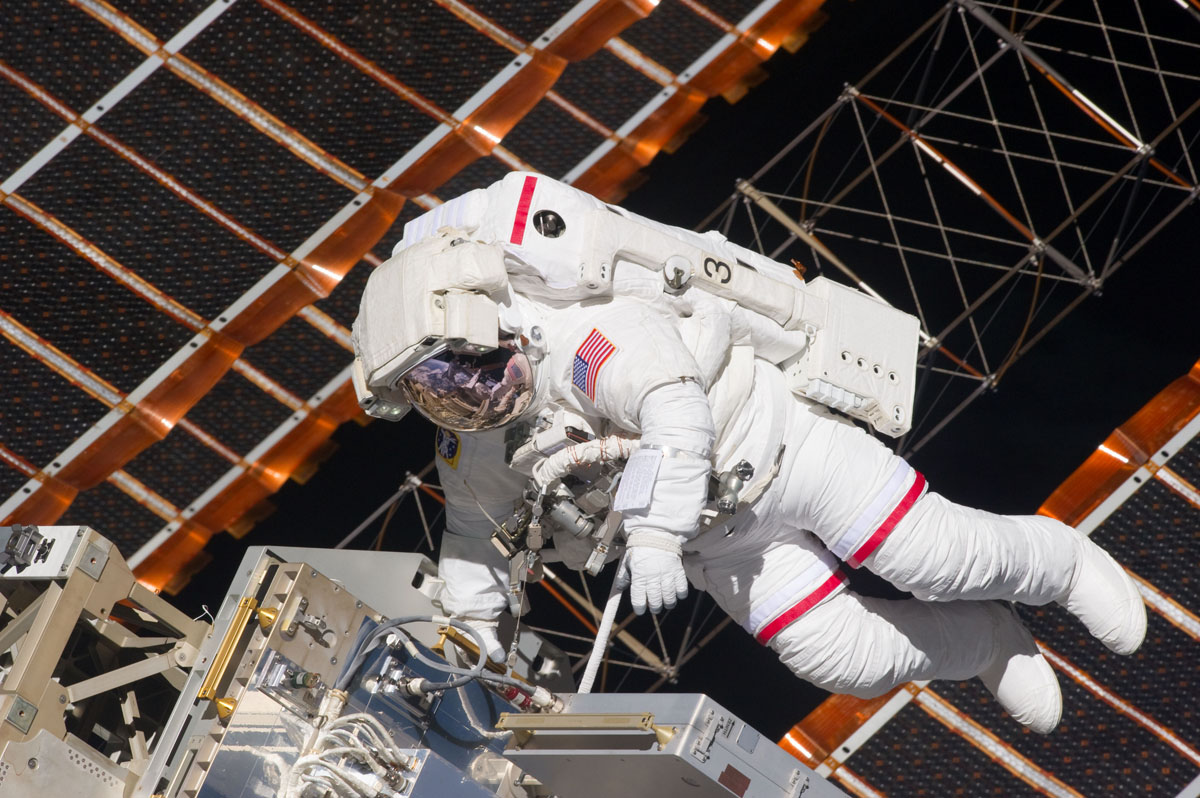Shuttle Astronauts Tackle Third Spacewalk at Space Station

This story was updated at 1:43 a.m. EDT on May 25.
HOUSTON – Two astronauts floated outside the International Space Station Wednesday (May 25) to upgrade the orbiting lab and complete some unfinished work from an earlier spacewalk.
Endeavour shuttle astronauts Andrew Feustel and Mike Fincke began the third spacewalk of their mission at 1:43 a.m. EDT (0543 GMT). The outing is expected to last about 6 1/2 hours. This is the sixth spacewalk of Feustel's career, and the seventh for Fincke. [Photos: Shuttle Endeavour's Final Mission]
"It's great to be back outside," Fincke said as he gazed down at Earth from 220 miles (354 kilometers) up. "It's the most beautiful planet in the universe."
"Nice view, isn't it," Feustel concurred.
Spacewalk objectives
Feustel and Fincke will complete work on an external wireless antenna system that was left unfinished from the first spacewalk of Endeavour's STS-134 mission, which was carried out by Feustel and mission specialist Greg Chamitoff. A carbon dioxide sensor on first time spacewalker Chamitoff's spacesuit forced flight controllers to err on the side of caution and end the spacewalk early.
Get the Space.com Newsletter
Breaking space news, the latest updates on rocket launches, skywatching events and more!
For today's spacewalk, Feustel and Fincke will complete the unfinished work on the antenna system. The remainder of the time will be spent working to beef up the power supply to the Russian side of the space station by adding redundancy to the system. [Endeavour's Final Mission Objectives]
The astronauts also aim to extend the reach of the space station's robotic arm to the area by adding a grapple fixture to the exterior of the Russian Zarya control module. This will essentially allow the robotic arm to "walk" to the Russian segment, using the grapple fixture as a base.
Previously, Feustel and Fincke performed the mission's second spacewalk on May 22, but ran into problems with some loose bolts and washers.
Mission managers decided to extend the length of the planned 6 1/2 hour-spacewalk, giving Feustel and Fincke enough time to finish work to refill the station's supply of ammonia coolant and lubricate a power system joint. The excursion lasted a total of 8 hours and 7 minutes, making it the sixth longest in history.
Endeavour's current mission is the 25th and final flight for the orbiter before it is retired along with the rest of NASA's fleet later this year. After Endeavour's 16-day mission ends next week, NASA plans to launch one last mission on the shuttle Endeavour before shutting down the storied 30-year program for good.
Beating the space bends
During preparations for today's spacewalk, the astronauts also tested a new calisthenics technique to help their bodies cope with the rigorous 6 1/2 hours of work while sealed inside a spacesuit.
"It's sort of a slow motion hokey pokey," lead spacewalk officer Allison Bolinger explained in a news briefing Tuesday (May 24).
Traditionally, spacewalkers camp out overnight in the Quest airlock to help their bodies adjust.
By lowering the pressure inside the airlock, the astronauts purge nitrogen from their bloodstream, which helps them reduce the risk of decompression sickness, or what is known as "the bends."
A new protocol, which is designed to replace the overnight airlock campout, will be tested before tomorrow's spacewalk. The procedure, called In-Suit Light Exercise (ISLE), begins with the astronauts donning oxygen masks for an hour, followed by depressurization of the airlock down to the levels typically used in U.S. spacesuits. [Infographic: Spacesuit Fashion Evolution]
They will then put on their spacesuits and spend about 100 minutes breathing oxygen at the spacesuit's pressure level. During this time, Feustel and Fincke will also engage in 50 minutes of light, in-suit exercise (such as lifting arms and legs inside the spacesuits), alternating with 50 minutes of in-suit breathing while resting.
Spacesuit calisthenics
This method has been successful in reducing the nitrogen content in the spacewalkers' blood in preparation for the depressurization and repressurization cycle, NASA officials said. The ISLE procedure is also expected to use less oxygen to prepare the spacewalkers for the higher oxygen environment that is required with the lowered pressure inside the spacesuit.
"One of the benefits of using the pre-breathe protocol is we use less oxygen," Bolinger said. "Post-shuttle retirement, this will be a big deal for the station." [Inside and Out: The International Space Station]
Performing the in-suit exercise method also means that the astronauts are not isolated in the airlock overnight, but the procedure does take longer to complete prior to the beginning of the spacewalk, Bolinger said.
If the new ISLE protocol is successful, it may also be used for the fourth and final spacewalk of the mission.
You can follow SPACE.com Staff Writer Denise Chow on Twitter @denisechow. Visit SPACE.com for complete coverage of Endeavour's final mission STS-134 or follow us @Spacedotcom and on Facebook.
Join our Space Forums to keep talking space on the latest missions, night sky and more! And if you have a news tip, correction or comment, let us know at: community@space.com.

Denise Chow is a former Space.com staff writer who then worked as assistant managing editor at Live Science before moving to NBC News as a science reporter, where she focuses on general science and climate change. She spent two years with Space.com, writing about rocket launches and covering NASA's final three space shuttle missions, before joining the Live Science team in 2013. A Canadian transplant, Denise has a bachelor's degree from the University of Toronto, and a master's degree in journalism from New York University. At NBC News, Denise covers general science and climate change.









